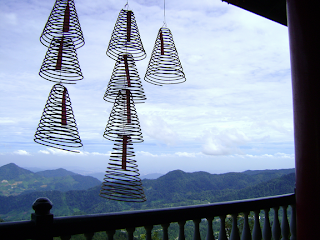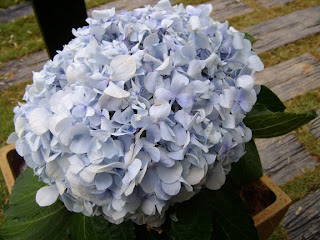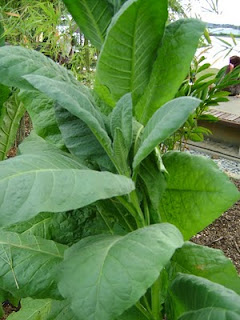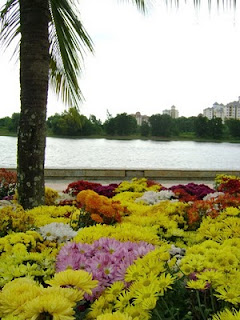Chin Swee Temple
Chin Swee Temple is a beautiful temple dedicated to Ven Pu Zu that is located at about 1.2 km below the Genting Highland hilltop complex. The temple is perched on the rocky mountainside of Gunung Ulu Kali, with a stunning view of the surrounding hills and Klang Valley below. Its popularity with locals has risen tremendously, and the temple is especially busy during the Lunar New Year period.
 |
| View of Chin Swee Temple from Level G. |
Who is Ven Pu Zu ?
The Ven. Pu Zu is a deitified monk from China of whom many in Malaysia pray to for guidance and help. Born Chen Zhao Eng (陳昭應, though some say Chen Eng, 陳應or Chen Zhao, 陳昭) in the village of Yong Chun in China, he entered monastic life at an early age with the Dharma name of Pu Zu (普足) and became a disciple of Zen Master Ming Song (明松禪師). Having attained a high level of spiritual enlightenment, Ven Pu Zu was able to bring rains to the people of An Xi County in Fujian Province that was suffering from drought.
Not only was he able to make the heavens pour when he prayed for rain, he was also touted as having gained insight to medical cures, which enabled him to cure locals who were sick. As a sign of veneration and respect, a monastery was built for him at the foot of Peng Lai Mountains, called Clear Water Crag (Qing Sui Yan - 清水巖), named after a clear stream coming from the rocky mountainside of that area. After he had passed away, he was venerated as Patriarch Master Chin Swee (Qing Sui Zu Shi).
What does he look like?
He is often depicted as a monk in ceremonial robes complete with the five dhyani Buddha hat, a black face and hands placed in front in a meditation pose. Why a black face, you may ask? Legend has it that on one occasion when he entered the cave at Qing Sui Yan to meditate, he was not welcomed by the four local demons (probably yakkhas) there and they tried to dispose him off by sealing the cave entrance and setting the mountain on fire.
For seven days and seven nights, the fire raged. The demons thought that by then, Ven. Pu Zu would have probably been reduced to ashes, if not just dead. Surprisingly, when the fire died down, he emerged from the cave alive and well, though visibly blackened by the soot from the fire. The four demons, overcame by Ven Pu Zu’s wisdom and attainment, became his faithful Dharma guardian deities.
Hence, Ven Pu Zu is often depicted as a black-faced monk as this represents him emerging victorious over his enemies by practicing forbearance and loving-kindness (no, he did not turn them into pillars of salt nor did he have them stoned, but won them over passively). This could be also be taken as an indication of his high spiritual attainment as those who do can prevent themselves from suffering bodily harm by entering into higher meditative state.
His image is not easily confused with other Chinese deities, many of which have black faces, due to his distinctively Buddhist attire. Amongst Buddhist images, he is different from Ksitigarbha Bodhisattva in that he does not hold the monastic staff in one hand and a Wish-Fulfilling Jewel in the other, in addition to his black appearance, which Ksitigarbha Bodhisattva does not have.
 |
| The black-faced Chin Swee Patriach Master (Main altar of Chin Swee Temple, Genting Highlands). |
From China to Malaysia
In 1850, a monk came from China to Penang with an image of Qing Sui Zu Shi, which was housed in a small temple that developed into the famous Temple of Pure/Clear Cloud Qing Yun Yan), better known as the Snake Temple of Bayan Lepas. From there, the miracles of Ven Pu Zu, or better known to the local Chinese there as Chor Soo Kong (Ancestral/Patriarch Master Deity) began to spread far and wide in Malaysia.
One of these involved David Brown, a Scottish planter whom donated the land on which the temple is sited. In 1873, he suffered from illness that could not be cured by Western medicine. Upon hearing of this Chinese deity ascribed with miracles of healing, he went and prayed to Chor Soo Kong. True enough, he was cured and as a token of thanksgiving, he donated a piece of land, which was part of his vast plantation, to the temple. Since a large number of Chinese in Penang were originally from Southeastern China, the temple has a large number of faithful devotees.
How did a Chin Swee Temple gets established in Genting Highlands?
The late Tan Sri Lim Goh Tong is a devout follower of Qing Sui Zu Shi, as are his parents. At one stage of the road construction for developing Genting Highlands, he had doubts whether the project would be successful. Turning to Qing Sui Zu Shi for guidance, the prediction that he received was auspicious, which strengthened his belief in the project and he forged ahead with the arduous road building. Just as predicted, the road construction, and the Genting development project was a great success.
As a sign of thanksgiving, he constructed the Chin Swee Temple at Genting Highlands. Apparently, in order to start the temple, the urn ash originally was taken from the Snake Temple in Penang. Later, when his business had grown and the temple extended, did he make a journey to Peng Lai in China to obtain the urn ash from there, thus formalizing the Chin Swee Temple of Genting Highlands as a direct branch of the Chin Swee Temple of Peng Lai Mountains.
The temple was continuously improved and the expansion project saw the addition of many features and amenities including the large seated Buddha at the upper terrace, observation tower and accommodation for people who wish to stay at the temple. In addition, a cable car stop was built for the Awana Genting Skyway at Chin Swee Temple to make it more accessible to visitors or devotees. The entire Chin Swee Temple complex is disabled-friendly with wheelchair ramps from the parking lot right up to the various attractions at the upper terrace.
How to get there?
Option One
Drive up to Chin Swee Temple. I would recommend that you turn in at the old entrance (the first entrance to the temple that you will encounter on the drive up to Genting). You will pass a rock arch and then you will see the ground floor entrance of the temple. There is ample parking available at the multi-storey parking lot here. If you had taken this option and had parked at levels besides the ground level, take the multi-storey parking lift up to Level G (the parking lot lifts only goes up to Level G).
Option Two
Do not turn at the first indication of the temple. Instead, drive further up and turn in at the second indication to the temple. You have a choice of parking at the parking lot after the junction or drive on a little and park besides the nine-tiered pagoda area. Be warned that there are limited parking spaces available here, especially during holiday season. Then you can walk to the arrival lobby at the main building (Level 12L) and take the lift to Level G to start your visit of the temple from the main entrance.
Option Three
Take the Awana Skyway (either from the top down or from Awana up) to Chin Swee Station. You will then have to walk past the nine-tiered pagoda to the main building (Level 12L) and take the lift down to Level G if you want to start your tour from the main entrance.
Option Four
If you are already at Genting Highlands, catch the shuttle from Highlands Hotel to Chin Swee Temple. Do check the schedule to ensure that you do not miss the last trip back up to Genting Highlands.
Level G – Main Entrance
Do spend some time to look at the temple complex from the outside. In addition, it is a good place to take photos of Klang Valley below and on a clear day, both KLCC and KL towers are clearly visible. At the main temple entrance level, the four guardians of Ven. Pu Zu, as well as the two Dharma guardians of Mahayana Buddhism in the entrance hall will greet you. From here, you can either take the steps outside that scale the hillside mountainside to the main shrine hall, or take the main lift and go to Level 7C for the main shrine hall.
 |
| A devotee offering incense to two of Ven. Pu Zu's guardians. |
Level 7C – Main Shrine Hall (Qing Sui Hall)
 |
| View of Chin Swee Temple Main Shrine Hall. |
The main shrine hall at level 7C houses the images of Ven. Pu Zu on the visibly ornate and gilded main altar. The small side altars flanking the main one houses other deities. On the left and right of the main shrine hall are the four guardian kings. The pillars and main door are covered in intricate and colourful relief images of heavenly beings and dragons. Underneath the main altar (a yellow sign with the words Holy Water points you there) a small stream trickles from the rocky mountainside, of which the water is said to have curative properties. You can sit in contemplation here, or observe people who come to pray and do stick divination. Some give a donation to get the temple staff to ring the bell and beat the drum, hoping to draw the attention of Ven. Pu Zu to their prayers.
Amulets (donation) and holy water (RM 5 per bottle) are available should you need further divine intervention. At this point, you should have noticed that the back wall of the temple is well, nonexistent. It is just the rocky mountainside! If you take the narrow stairway on the left of the temple, it will lead you up the hill side to the nine-tiered pagoda at 12L. The stairs to the right will also lead you to Level 12L, passing by the ‘Tales of Filial Piety’ wall.
 |
| Tales of Filial Piety wall. |
Outside Level 7C is a tortoise and a carp pond. Do take time to enjoy the cool breeze and the picturesque view at the front terrace. You must keep an eye on where you stand though, for the coiled incense hanging overhead might drop hot incense ash on you.
 |
| Coiled incense hanging outside the main shrine hall. |
 |
| Terrapins basking in the sun |
The altar for Jade Emperor is intricately decorated with motifs of mystical animals. The front wall of the temple is likewise covered with relief carvings of mythical scenes and dragons.
 |
| Ornate carving on the altar for Jade Emperor. |
 |
| Another view of the altar for Jade Emperor. |
 |
| Entrance to the main shrine hall. |
Standing at the terrace, you may occasionally catch wafts of harsh smoke from the joss paper burner located at the right hand side of the temple (when you are outside looking in). Take a closer look at the burner if you had not done so when you were heading to the main shrine hall from the lifts, and you will notice that desperate punters had scribbled four digit numbers on the walls of the burner, in hopes of striking the jackpot.
 |
| Joss paper burner where punters have scribbled 4 digit numbers. |
Level 12L – Arrival Lobby
Within the building, you can find a vegetarian restaurant, the check-in counter for the temple accommodations, a souvenir shop, as well as magnificent wood, stone and metal Buddhist images belonging to Tan Sri Lim Kok Thay on display. T
he wooden ones are of special interest, as they are carved from whole, large tree trunks and stumps. There are also balconies that open out should you need to catch some fresh air whilst enjoying the view or want to give yourself vertigo.
The vegetarian restaurant has set meals as well as individual dishes or noodle dishes that you can order. Food is a little pricey (typical of large temple restaurants – a good rule of thumb: the more tiers the pagoda of the temple, the higher the price of the food sold there) but the quality of the food served is reasonable. The restaurant offers a good view of the ornate dragons atop the main shrine hall roof as well as the view of the surrounding area if you are seated by the window.
Outside, at Level 12L (to the left of the main building as you exit), you can find the some stalls selling snacks and drinks, souvenirs and even fresh local produce. Further on is the 9-storey pagoda. On the far right and across the road, you can see the Maitreya shrine which sits directly beneath the huge statue of the Buddha at Level 13S.
Level 13S – Sky Terrace and Observation Tower
One can visit yet another shrine hall, or wander about the terrace. There is a statue of the late founder of Genting Highlands. Statues of various fairies supposedly give you a feeling that you are amongst the gods in heaven. There is also a large seated Buddha at the far right of the terrace. For those who loved the gore of the dreadful depiction of hell found in Haw Paw Villa of Singapore, well, you can get a similar thrill from taking the Journey through Hell at the upper terrace. This rather disturbing display was done by the temple as a reminder to children to be filial to their parents.
Chinese believed that everyone goes to the courts of hell to be judged before you get reincarnated, regardless of which realm you will end up with. If you are bad, you get to stay in hell for a long, long time. The Buddhist view however, is different, as you will get reborn into any of the possible realms once you die, without the need to go through hell. Of course hell is one of the rather unfortunate options that may befall upon one. Being reborn of course means you are still caught in Samsara, thus will end up suffering.
One notable thing is that this ‘journey’ is accessible even to those on wheelchair, though the gradient of the path can be a little steep at certain stretches. If such gore is not your cup of tea and makes your stomach churn, then head to the observation tower, which is accessible by a flight of stairs located at the side of the elevator. Looking down from the observation tower may prove be more stomach wrenching than the ‘Journey through Hell’ for those who are afraid of heights.
 |
| Large seated Buddha at the Upper Terrace. |
To calm your stomach down, try going down the steps located on the left hand side of the terrace to Level 12L. There, a few stalls selling light refreshments and snacks might be of help. Once you are done, head towards the 9-storey pagoda. You can climb all the way up to the ninth floor to get a feeling of being up in the clouds. Do not forget to take a picture of yourself with the floor label, to cast away any doubts that your friends may have of you having climbed up nine storey’s worth of steps to go…well nowhere.
 |
| Nine storey pagoda of Chin Swee Temple. |
Conclusion
As a whole, the temple is a lovely little place to visit if you are on the way up to Genting Highlands. Despite being a little garish (especially the sky terrace), it is far more sublime and relaxing than the head-throbbing lights, gaudy colours and the maddening crowd that is Genting Highlands. A word of advice, if you are looking for peace and serenity, then you may want to avoid the sky terrace and stick to the main shrine hall, especially on weekends. It is also notable that the temple was built to be disabled-friendly.























































